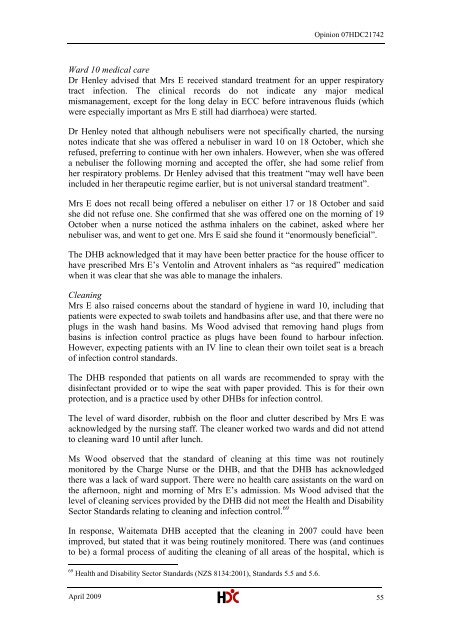North Shore Hospital report - New Zealand Doctor
North Shore Hospital report - New Zealand Doctor
North Shore Hospital report - New Zealand Doctor
You also want an ePaper? Increase the reach of your titles
YUMPU automatically turns print PDFs into web optimized ePapers that Google loves.
Opinion 07HDC21742Ward 10 medical careDr Henley advised that Mrs E received standard treatment for an upper respiratorytract infection. The clinical records do not indicate any major medicalmismanagement, except for the long delay in ECC before intravenous fluids (whichwere especially important as Mrs E still had diarrhoea) were started.Dr Henley noted that although nebulisers were not specifically charted, the nursingnotes indicate that she was offered a nebuliser in ward 10 on 18 October, which sherefused, preferring to continue with her own inhalers. However, when she was offereda nebuliser the following morning and accepted the offer, she had some relief fromher respiratory problems. Dr Henley advised that this treatment ―may well have beenincluded in her therapeutic regime earlier, but is not universal standard treatment‖.Mrs E does not recall being offered a nebuliser on either 17 or 18 October and saidshe did not refuse one. She confirmed that she was offered one on the morning of 19October when a nurse noticed the asthma inhalers on the cabinet, asked where hernebuliser was, and went to get one. Mrs E said she found it ―enormously beneficial‖.The DHB acknowledged that it may have been better practice for the house officer tohave prescribed Mrs E‘s Ventolin and Atrovent inhalers as ―as required‖ medicationwhen it was clear that she was able to manage the inhalers.CleaningMrs E also raised concerns about the standard of hygiene in ward 10, including thatpatients were expected to swab toilets and handbasins after use, and that there were noplugs in the wash hand basins. Ms Wood advised that removing hand plugs frombasins is infection control practice as plugs have been found to harbour infection.However, expecting patients with an IV line to clean their own toilet seat is a breachof infection control standards.The DHB responded that patients on all wards are recommended to spray with thedisinfectant provided or to wipe the seat with paper provided. This is for their ownprotection, and is a practice used by other DHBs for infection control.The level of ward disorder, rubbish on the floor and clutter described by Mrs E wasacknowledged by the nursing staff. The cleaner worked two wards and did not attendto cleaning ward 10 until after lunch.Ms Wood observed that the standard of cleaning at this time was not routinelymonitored by the Charge Nurse or the DHB, and that the DHB has acknowledgedthere was a lack of ward support. There were no health care assistants on the ward onthe afternoon, night and morning of Mrs E‘s admission. Ms Wood advised that thelevel of cleaning services provided by the DHB did not meet the Health and DisabilitySector Standards relating to cleaning and infection control. 69In response, Waitemata DHB accepted that the cleaning in 2007 could have beenimproved, but stated that it was being routinely monitored. There was (and continuesto be) a formal process of auditing the cleaning of all areas of the hospital, which is69 Health and Disability Sector Standards (NZS 8134:2001), Standards 5.5 and 5.6.April 2009 55
















